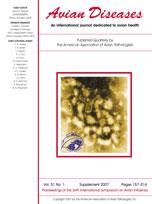The role of migrating birds as potential vectors for avian influenza virus (AIV) was investigated. We captured 543 migrating passerines during their stopover on the island of Helgoland (North Sea) in spring and autumn 2001. These birds were sampled for avian influenza A viruses (AIV), specifically the subtypes H5 and H7. For virus detection, samples were taken from 1) short-distance migrants, such as chaffinches (Fringilla coelebs; n = 131) and song thrushes (Turdus philomelos; n = 169); and 2) long-distance migrants, such as garden warblers (Sylvia borin; n = 142) and common redstarts (Phoenicurus phoenicurus; n = 101). Virus isolation assays failed to identify AIV. Therefore, regarding the actual low number of samples, we speculate that the tested four species of passerines were not infected by AIV, indicating that the passerine species examined in this study may play only a minor role as potential vectors of AIV.
How to translate text using browser tools
1 March 2007
Investigations on Infection Status with H5 and H7 Avian Influenza Virus in Short-Distance and Long-Distance Migrant Birds in 2001
B. Schnebel,
V. Dierschke,
S. Rautenschlein,
M. Ryll,
U. Neumann
ACCESS THE FULL ARTICLE

Avian Diseases
Vol. 51 • No. s1
March 2007
Vol. 51 • No. s1
March 2007
avian influenza virus
epidemiology
migrating passerines
vectors
zoonosis




